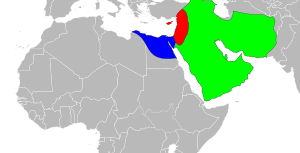First Fitna
| First Fitna | |||||||
|---|---|---|---|---|---|---|---|
| Part of the Fitnas | |||||||

Region under the control of Muawiyah I
Region under the control of Amr ibn al-As
|
|||||||
|
|||||||
| Belligerents | |||||||
| Rashidun Caliphate |
Aisha's forces Muawiya's forces |
||||||
| Commanders and leaders | |||||||
|
Ali ibn Abi Talib Ammar ibn Yasir Malik al-Ashtar |
Aisha bint Abu Bakr Talha ibn Ubayd-Allah Zubair ibn al-Awam Muawiya I 'Amr ibn al-'As[b] |
||||||
|
|||||||
The First Fitna or First confusion (Arabic: فتنة مقتل عثمان, translit. Fitnat Maqtal ʿUthmān, lit. 'Fitna of the Killing of Uthman') was a civil war within the Rashidun Caliphate which resulted in the overthrowing of the Rashidun caliphs and the establishment of the Umayyad dynasty. It began when the caliph Uthman ibn Affan was assassinated by Egyptian rebels in 656 and continued through the four-year reign of Uthman's successor Ali ibn Abi Talib. It ended in 661 when Ali's heir Hasan ibn Ali concluded a treaty acknowledging the rule of Muawiyah, the first Umayyad caliph.
The Islamic state expanded very quickly under Muhammad and the first three caliphs. In 639 Muawiyah I was appointed the Governor of Syria by Umar after his elder brother Yazid ibn Abi Sufyan (Governor of Syria) died in a plague, along with Abu Ubaidah ibn al-Jarrah (the Governor before him) and 25,000 other people.
The rapid Muslim conquest of Syria and Egypt and the consequent Byzantine losses in manpower and territory meant that the Eastern Roman Empire found itself struggling for survival. The Sassanid Dynasty in Persia had already collapsed.
...
Wikipedia
